Business Environment Analysis of Primark: A Comprehensive Report
VerifiedAdded on 2019/12/18
|14
|4927
|229
Report
AI Summary
This report provides a comprehensive analysis of Primark's business environment. It begins with an introduction to Primark, a subsidiary of Associated British Foods (ABF), and its operations within the fashion industry, including its business model and objectives. The report then explores the different types of organizations, focusing on Primark as a private company and its purpose of maximizing wealth and profits, as well as its responsibilities to various stakeholders such as employees, customers, and suppliers. The report also examines different economic systems, including traditional, command, market, and mixed economies, and how they allocate resources, with a focus on the UK's mixed economy. Furthermore, it discusses the impact of fiscal and monetary policies on businesses, including farming and housing sectors. The report concludes by assessing the significance of international trade to UK businesses, the impact of global factors, and the effects of European Union policies on UK business organizations.
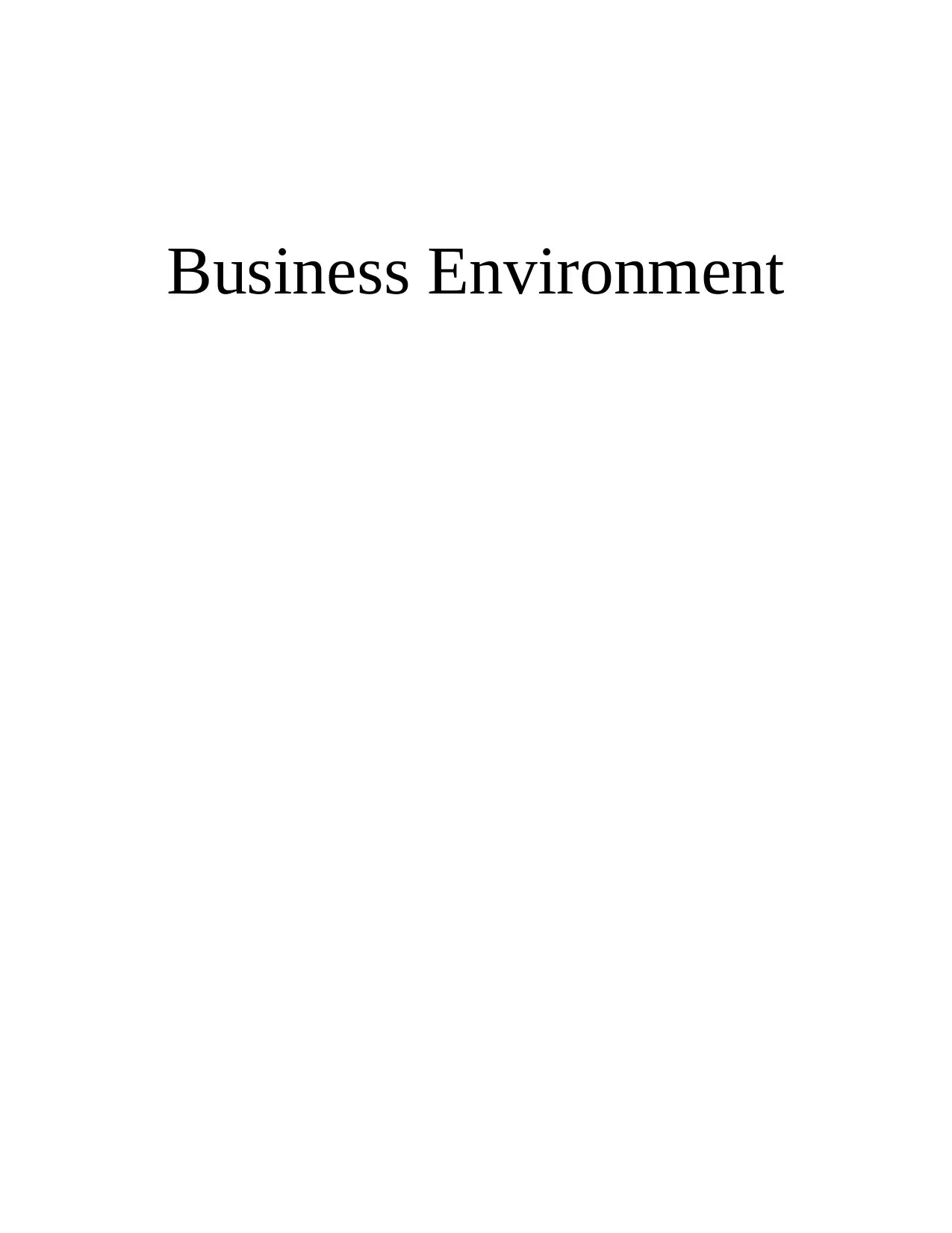
Business Environment
Paraphrase This Document
Need a fresh take? Get an instant paraphrase of this document with our AI Paraphraser
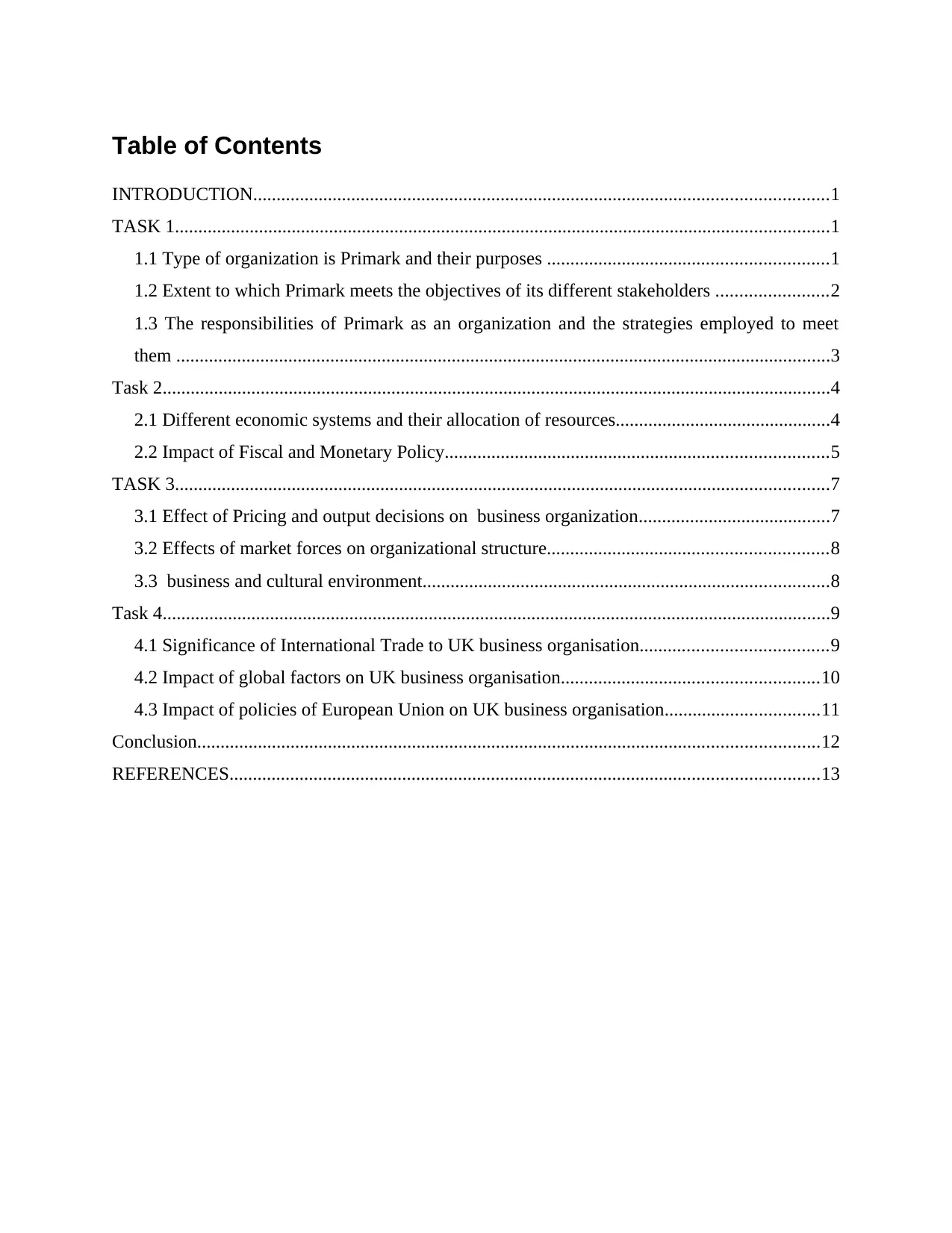
Table of Contents
INTRODUCTION...........................................................................................................................1
TASK 1............................................................................................................................................1
1.1 Type of organization is Primark and their purposes ............................................................1
1.2 Extent to which Primark meets the objectives of its different stakeholders ........................2
1.3 The responsibilities of Primark as an organization and the strategies employed to meet
them ............................................................................................................................................3
Task 2...............................................................................................................................................4
2.1 Different economic systems and their allocation of resources..............................................4
2.2 Impact of Fiscal and Monetary Policy..................................................................................5
TASK 3............................................................................................................................................7
3.1 Effect of Pricing and output decisions on business organization.........................................7
3.2 Effects of market forces on organizational structure............................................................8
3.3 business and cultural environment.......................................................................................8
Task 4...............................................................................................................................................9
4.1 Significance of International Trade to UK business organisation........................................9
4.2 Impact of global factors on UK business organisation.......................................................10
4.3 Impact of policies of European Union on UK business organisation.................................11
Conclusion.....................................................................................................................................12
REFERENCES..............................................................................................................................13
INTRODUCTION...........................................................................................................................1
TASK 1............................................................................................................................................1
1.1 Type of organization is Primark and their purposes ............................................................1
1.2 Extent to which Primark meets the objectives of its different stakeholders ........................2
1.3 The responsibilities of Primark as an organization and the strategies employed to meet
them ............................................................................................................................................3
Task 2...............................................................................................................................................4
2.1 Different economic systems and their allocation of resources..............................................4
2.2 Impact of Fiscal and Monetary Policy..................................................................................5
TASK 3............................................................................................................................................7
3.1 Effect of Pricing and output decisions on business organization.........................................7
3.2 Effects of market forces on organizational structure............................................................8
3.3 business and cultural environment.......................................................................................8
Task 4...............................................................................................................................................9
4.1 Significance of International Trade to UK business organisation........................................9
4.2 Impact of global factors on UK business organisation.......................................................10
4.3 Impact of policies of European Union on UK business organisation.................................11
Conclusion.....................................................................................................................................12
REFERENCES..............................................................................................................................13
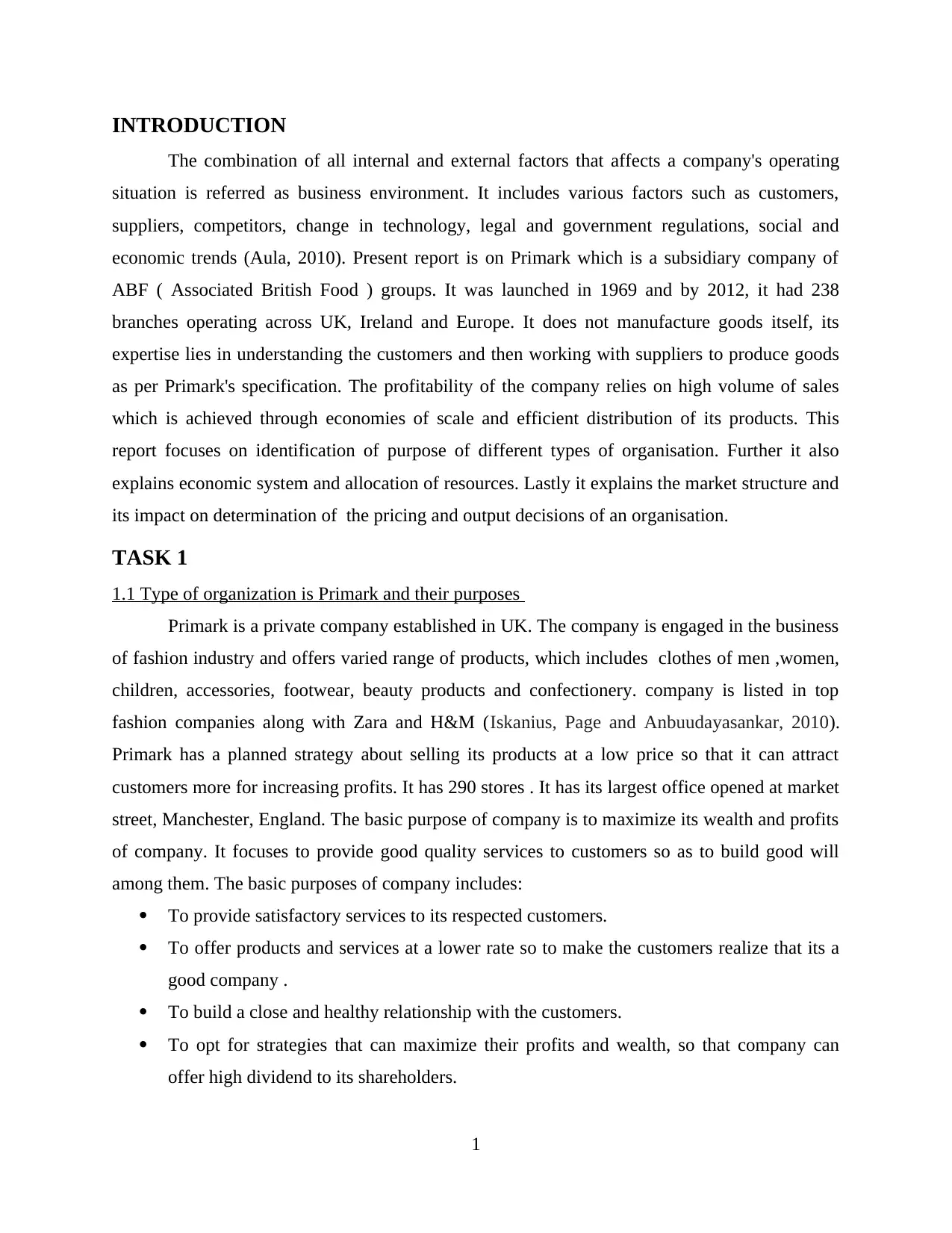
INTRODUCTION
The combination of all internal and external factors that affects a company's operating
situation is referred as business environment. It includes various factors such as customers,
suppliers, competitors, change in technology, legal and government regulations, social and
economic trends (Aula, 2010). Present report is on Primark which is a subsidiary company of
ABF ( Associated British Food ) groups. It was launched in 1969 and by 2012, it had 238
branches operating across UK, Ireland and Europe. It does not manufacture goods itself, its
expertise lies in understanding the customers and then working with suppliers to produce goods
as per Primark's specification. The profitability of the company relies on high volume of sales
which is achieved through economies of scale and efficient distribution of its products. This
report focuses on identification of purpose of different types of organisation. Further it also
explains economic system and allocation of resources. Lastly it explains the market structure and
its impact on determination of the pricing and output decisions of an organisation.
TASK 1
1.1 Type of organization is Primark and their purposes
Primark is a private company established in UK. The company is engaged in the business
of fashion industry and offers varied range of products, which includes clothes of men ,women,
children, accessories, footwear, beauty products and confectionery. company is listed in top
fashion companies along with Zara and H&M (Iskanius, Page and Anbuudayasankar, 2010).
Primark has a planned strategy about selling its products at a low price so that it can attract
customers more for increasing profits. It has 290 stores . It has its largest office opened at market
street, Manchester, England. The basic purpose of company is to maximize its wealth and profits
of company. It focuses to provide good quality services to customers so as to build good will
among them. The basic purposes of company includes:
To provide satisfactory services to its respected customers.
To offer products and services at a lower rate so to make the customers realize that its a
good company .
To build a close and healthy relationship with the customers.
To opt for strategies that can maximize their profits and wealth, so that company can
offer high dividend to its shareholders.
1
The combination of all internal and external factors that affects a company's operating
situation is referred as business environment. It includes various factors such as customers,
suppliers, competitors, change in technology, legal and government regulations, social and
economic trends (Aula, 2010). Present report is on Primark which is a subsidiary company of
ABF ( Associated British Food ) groups. It was launched in 1969 and by 2012, it had 238
branches operating across UK, Ireland and Europe. It does not manufacture goods itself, its
expertise lies in understanding the customers and then working with suppliers to produce goods
as per Primark's specification. The profitability of the company relies on high volume of sales
which is achieved through economies of scale and efficient distribution of its products. This
report focuses on identification of purpose of different types of organisation. Further it also
explains economic system and allocation of resources. Lastly it explains the market structure and
its impact on determination of the pricing and output decisions of an organisation.
TASK 1
1.1 Type of organization is Primark and their purposes
Primark is a private company established in UK. The company is engaged in the business
of fashion industry and offers varied range of products, which includes clothes of men ,women,
children, accessories, footwear, beauty products and confectionery. company is listed in top
fashion companies along with Zara and H&M (Iskanius, Page and Anbuudayasankar, 2010).
Primark has a planned strategy about selling its products at a low price so that it can attract
customers more for increasing profits. It has 290 stores . It has its largest office opened at market
street, Manchester, England. The basic purpose of company is to maximize its wealth and profits
of company. It focuses to provide good quality services to customers so as to build good will
among them. The basic purposes of company includes:
To provide satisfactory services to its respected customers.
To offer products and services at a lower rate so to make the customers realize that its a
good company .
To build a close and healthy relationship with the customers.
To opt for strategies that can maximize their profits and wealth, so that company can
offer high dividend to its shareholders.
1
⊘ This is a preview!⊘
Do you want full access?
Subscribe today to unlock all pages.

Trusted by 1+ million students worldwide
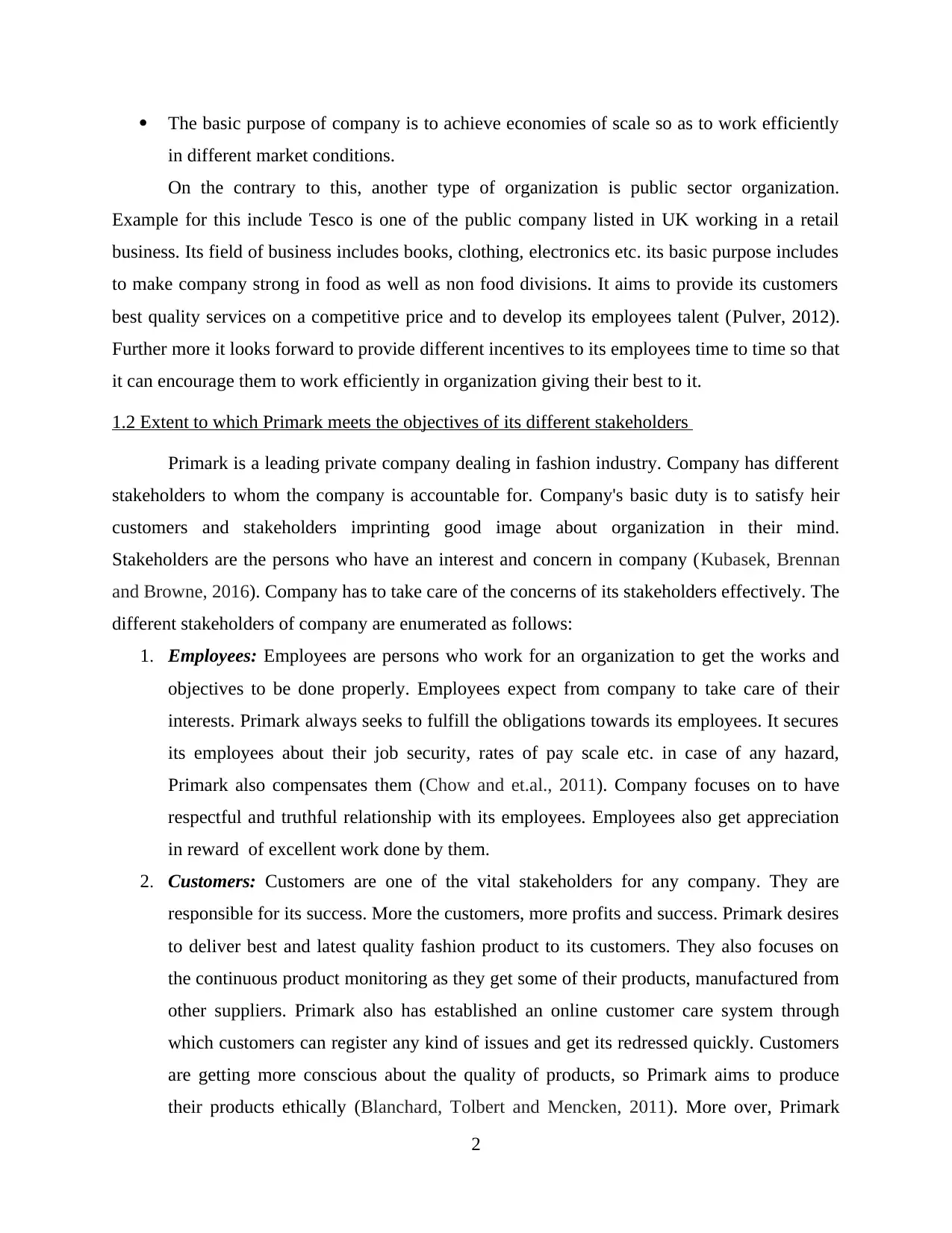
The basic purpose of company is to achieve economies of scale so as to work efficiently
in different market conditions.
On the contrary to this, another type of organization is public sector organization.
Example for this include Tesco is one of the public company listed in UK working in a retail
business. Its field of business includes books, clothing, electronics etc. its basic purpose includes
to make company strong in food as well as non food divisions. It aims to provide its customers
best quality services on a competitive price and to develop its employees talent (Pulver, 2012).
Further more it looks forward to provide different incentives to its employees time to time so that
it can encourage them to work efficiently in organization giving their best to it.
1.2 Extent to which Primark meets the objectives of its different stakeholders
Primark is a leading private company dealing in fashion industry. Company has different
stakeholders to whom the company is accountable for. Company's basic duty is to satisfy heir
customers and stakeholders imprinting good image about organization in their mind.
Stakeholders are the persons who have an interest and concern in company (Kubasek, Brennan
and Browne, 2016). Company has to take care of the concerns of its stakeholders effectively. The
different stakeholders of company are enumerated as follows:
1. Employees: Employees are persons who work for an organization to get the works and
objectives to be done properly. Employees expect from company to take care of their
interests. Primark always seeks to fulfill the obligations towards its employees. It secures
its employees about their job security, rates of pay scale etc. in case of any hazard,
Primark also compensates them (Chow and et.al., 2011). Company focuses on to have
respectful and truthful relationship with its employees. Employees also get appreciation
in reward of excellent work done by them.
2. Customers: Customers are one of the vital stakeholders for any company. They are
responsible for its success. More the customers, more profits and success. Primark desires
to deliver best and latest quality fashion product to its customers. They also focuses on
the continuous product monitoring as they get some of their products, manufactured from
other suppliers. Primark also has established an online customer care system through
which customers can register any kind of issues and get its redressed quickly. Customers
are getting more conscious about the quality of products, so Primark aims to produce
their products ethically (Blanchard, Tolbert and Mencken, 2011). More over, Primark
2
in different market conditions.
On the contrary to this, another type of organization is public sector organization.
Example for this include Tesco is one of the public company listed in UK working in a retail
business. Its field of business includes books, clothing, electronics etc. its basic purpose includes
to make company strong in food as well as non food divisions. It aims to provide its customers
best quality services on a competitive price and to develop its employees talent (Pulver, 2012).
Further more it looks forward to provide different incentives to its employees time to time so that
it can encourage them to work efficiently in organization giving their best to it.
1.2 Extent to which Primark meets the objectives of its different stakeholders
Primark is a leading private company dealing in fashion industry. Company has different
stakeholders to whom the company is accountable for. Company's basic duty is to satisfy heir
customers and stakeholders imprinting good image about organization in their mind.
Stakeholders are the persons who have an interest and concern in company (Kubasek, Brennan
and Browne, 2016). Company has to take care of the concerns of its stakeholders effectively. The
different stakeholders of company are enumerated as follows:
1. Employees: Employees are persons who work for an organization to get the works and
objectives to be done properly. Employees expect from company to take care of their
interests. Primark always seeks to fulfill the obligations towards its employees. It secures
its employees about their job security, rates of pay scale etc. in case of any hazard,
Primark also compensates them (Chow and et.al., 2011). Company focuses on to have
respectful and truthful relationship with its employees. Employees also get appreciation
in reward of excellent work done by them.
2. Customers: Customers are one of the vital stakeholders for any company. They are
responsible for its success. More the customers, more profits and success. Primark desires
to deliver best and latest quality fashion product to its customers. They also focuses on
the continuous product monitoring as they get some of their products, manufactured from
other suppliers. Primark also has established an online customer care system through
which customers can register any kind of issues and get its redressed quickly. Customers
are getting more conscious about the quality of products, so Primark aims to produce
their products ethically (Blanchard, Tolbert and Mencken, 2011). More over, Primark
2
Paraphrase This Document
Need a fresh take? Get an instant paraphrase of this document with our AI Paraphraser
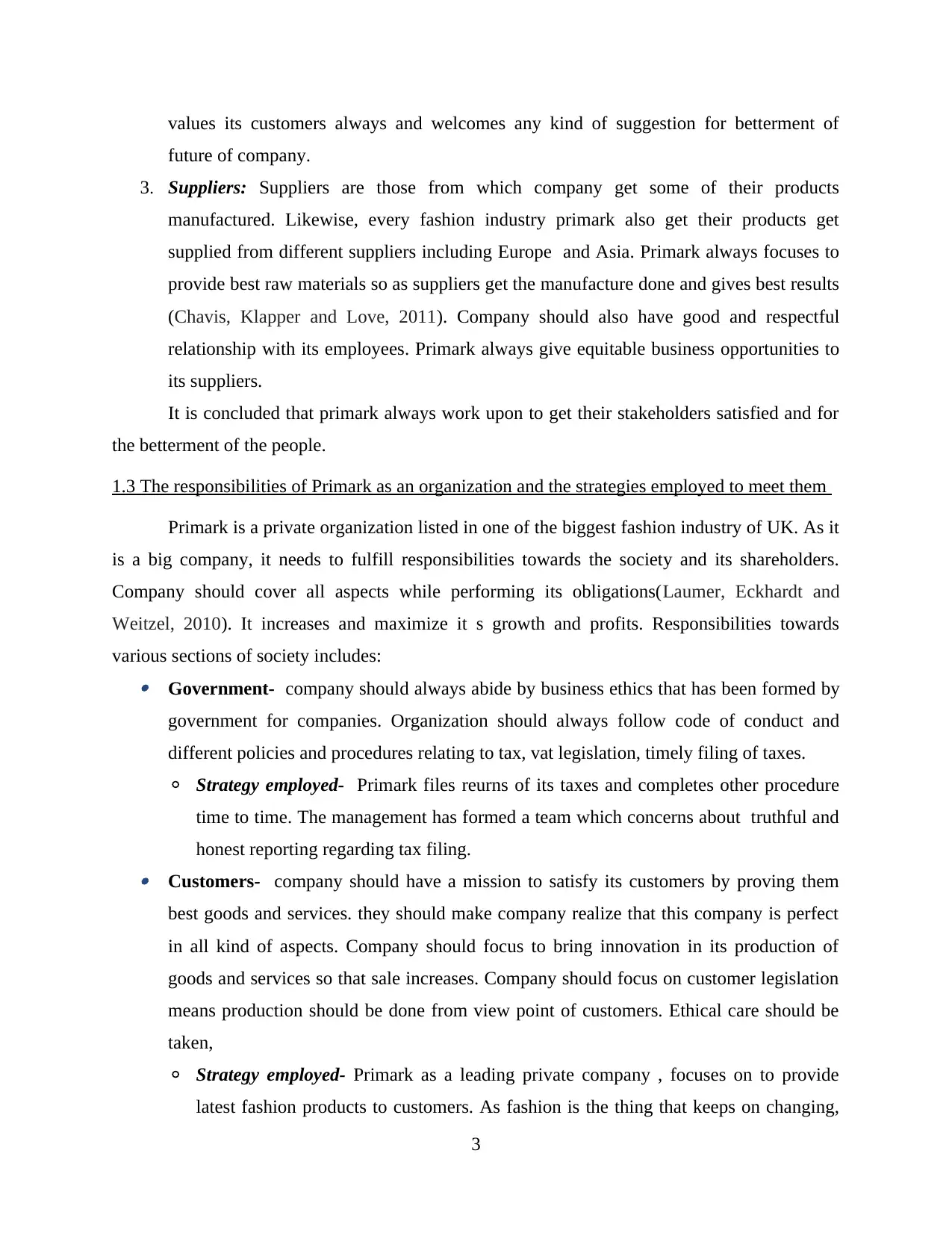
values its customers always and welcomes any kind of suggestion for betterment of
future of company.
3. Suppliers: Suppliers are those from which company get some of their products
manufactured. Likewise, every fashion industry primark also get their products get
supplied from different suppliers including Europe and Asia. Primark always focuses to
provide best raw materials so as suppliers get the manufacture done and gives best results
(Chavis, Klapper and Love, 2011). Company should also have good and respectful
relationship with its employees. Primark always give equitable business opportunities to
its suppliers.
It is concluded that primark always work upon to get their stakeholders satisfied and for
the betterment of the people.
1.3 The responsibilities of Primark as an organization and the strategies employed to meet them
Primark is a private organization listed in one of the biggest fashion industry of UK. As it
is a big company, it needs to fulfill responsibilities towards the society and its shareholders.
Company should cover all aspects while performing its obligations(Laumer, Eckhardt and
Weitzel, 2010). It increases and maximize it s growth and profits. Responsibilities towards
various sections of society includes: Government- company should always abide by business ethics that has been formed by
government for companies. Organization should always follow code of conduct and
different policies and procedures relating to tax, vat legislation, timely filing of taxes.
◦ Strategy employed- Primark files reurns of its taxes and completes other procedure
time to time. The management has formed a team which concerns about truthful and
honest reporting regarding tax filing. Customers- company should have a mission to satisfy its customers by proving them
best goods and services. they should make company realize that this company is perfect
in all kind of aspects. Company should focus to bring innovation in its production of
goods and services so that sale increases. Company should focus on customer legislation
means production should be done from view point of customers. Ethical care should be
taken,
◦ Strategy employed- Primark as a leading private company , focuses on to provide
latest fashion products to customers. As fashion is the thing that keeps on changing,
3
future of company.
3. Suppliers: Suppliers are those from which company get some of their products
manufactured. Likewise, every fashion industry primark also get their products get
supplied from different suppliers including Europe and Asia. Primark always focuses to
provide best raw materials so as suppliers get the manufacture done and gives best results
(Chavis, Klapper and Love, 2011). Company should also have good and respectful
relationship with its employees. Primark always give equitable business opportunities to
its suppliers.
It is concluded that primark always work upon to get their stakeholders satisfied and for
the betterment of the people.
1.3 The responsibilities of Primark as an organization and the strategies employed to meet them
Primark is a private organization listed in one of the biggest fashion industry of UK. As it
is a big company, it needs to fulfill responsibilities towards the society and its shareholders.
Company should cover all aspects while performing its obligations(Laumer, Eckhardt and
Weitzel, 2010). It increases and maximize it s growth and profits. Responsibilities towards
various sections of society includes: Government- company should always abide by business ethics that has been formed by
government for companies. Organization should always follow code of conduct and
different policies and procedures relating to tax, vat legislation, timely filing of taxes.
◦ Strategy employed- Primark files reurns of its taxes and completes other procedure
time to time. The management has formed a team which concerns about truthful and
honest reporting regarding tax filing. Customers- company should have a mission to satisfy its customers by proving them
best goods and services. they should make company realize that this company is perfect
in all kind of aspects. Company should focus to bring innovation in its production of
goods and services so that sale increases. Company should focus on customer legislation
means production should be done from view point of customers. Ethical care should be
taken,
◦ Strategy employed- Primark as a leading private company , focuses on to provide
latest fashion products to customers. As fashion is the thing that keeps on changing,
3
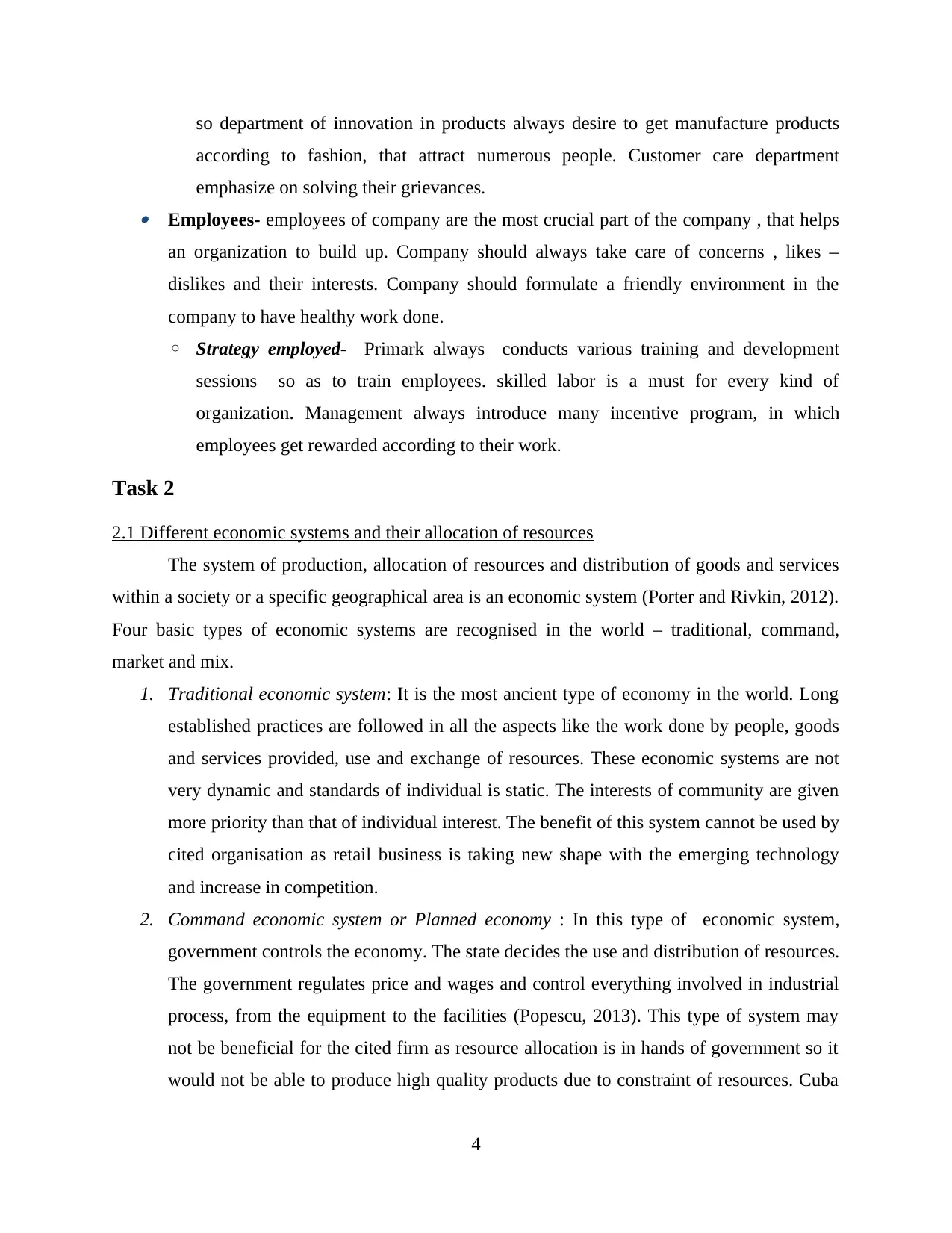
so department of innovation in products always desire to get manufacture products
according to fashion, that attract numerous people. Customer care department
emphasize on solving their grievances. Employees- employees of company are the most crucial part of the company , that helps
an organization to build up. Company should always take care of concerns , likes –
dislikes and their interests. Company should formulate a friendly environment in the
company to have healthy work done.
◦ Strategy employed- Primark always conducts various training and development
sessions so as to train employees. skilled labor is a must for every kind of
organization. Management always introduce many incentive program, in which
employees get rewarded according to their work.
Task 2
2.1 Different economic systems and their allocation of resources
The system of production, allocation of resources and distribution of goods and services
within a society or a specific geographical area is an economic system (Porter and Rivkin, 2012).
Four basic types of economic systems are recognised in the world – traditional, command,
market and mix.
1. Traditional economic system: It is the most ancient type of economy in the world. Long
established practices are followed in all the aspects like the work done by people, goods
and services provided, use and exchange of resources. These economic systems are not
very dynamic and standards of individual is static. The interests of community are given
more priority than that of individual interest. The benefit of this system cannot be used by
cited organisation as retail business is taking new shape with the emerging technology
and increase in competition.
2. Command economic system or Planned economy : In this type of economic system,
government controls the economy. The state decides the use and distribution of resources.
The government regulates price and wages and control everything involved in industrial
process, from the equipment to the facilities (Popescu, 2013). This type of system may
not be beneficial for the cited firm as resource allocation is in hands of government so it
would not be able to produce high quality products due to constraint of resources. Cuba
4
according to fashion, that attract numerous people. Customer care department
emphasize on solving their grievances. Employees- employees of company are the most crucial part of the company , that helps
an organization to build up. Company should always take care of concerns , likes –
dislikes and their interests. Company should formulate a friendly environment in the
company to have healthy work done.
◦ Strategy employed- Primark always conducts various training and development
sessions so as to train employees. skilled labor is a must for every kind of
organization. Management always introduce many incentive program, in which
employees get rewarded according to their work.
Task 2
2.1 Different economic systems and their allocation of resources
The system of production, allocation of resources and distribution of goods and services
within a society or a specific geographical area is an economic system (Porter and Rivkin, 2012).
Four basic types of economic systems are recognised in the world – traditional, command,
market and mix.
1. Traditional economic system: It is the most ancient type of economy in the world. Long
established practices are followed in all the aspects like the work done by people, goods
and services provided, use and exchange of resources. These economic systems are not
very dynamic and standards of individual is static. The interests of community are given
more priority than that of individual interest. The benefit of this system cannot be used by
cited organisation as retail business is taking new shape with the emerging technology
and increase in competition.
2. Command economic system or Planned economy : In this type of economic system,
government controls the economy. The state decides the use and distribution of resources.
The government regulates price and wages and control everything involved in industrial
process, from the equipment to the facilities (Popescu, 2013). This type of system may
not be beneficial for the cited firm as resource allocation is in hands of government so it
would not be able to produce high quality products due to constraint of resources. Cuba
4
⊘ This is a preview!⊘
Do you want full access?
Subscribe today to unlock all pages.

Trusted by 1+ million students worldwide
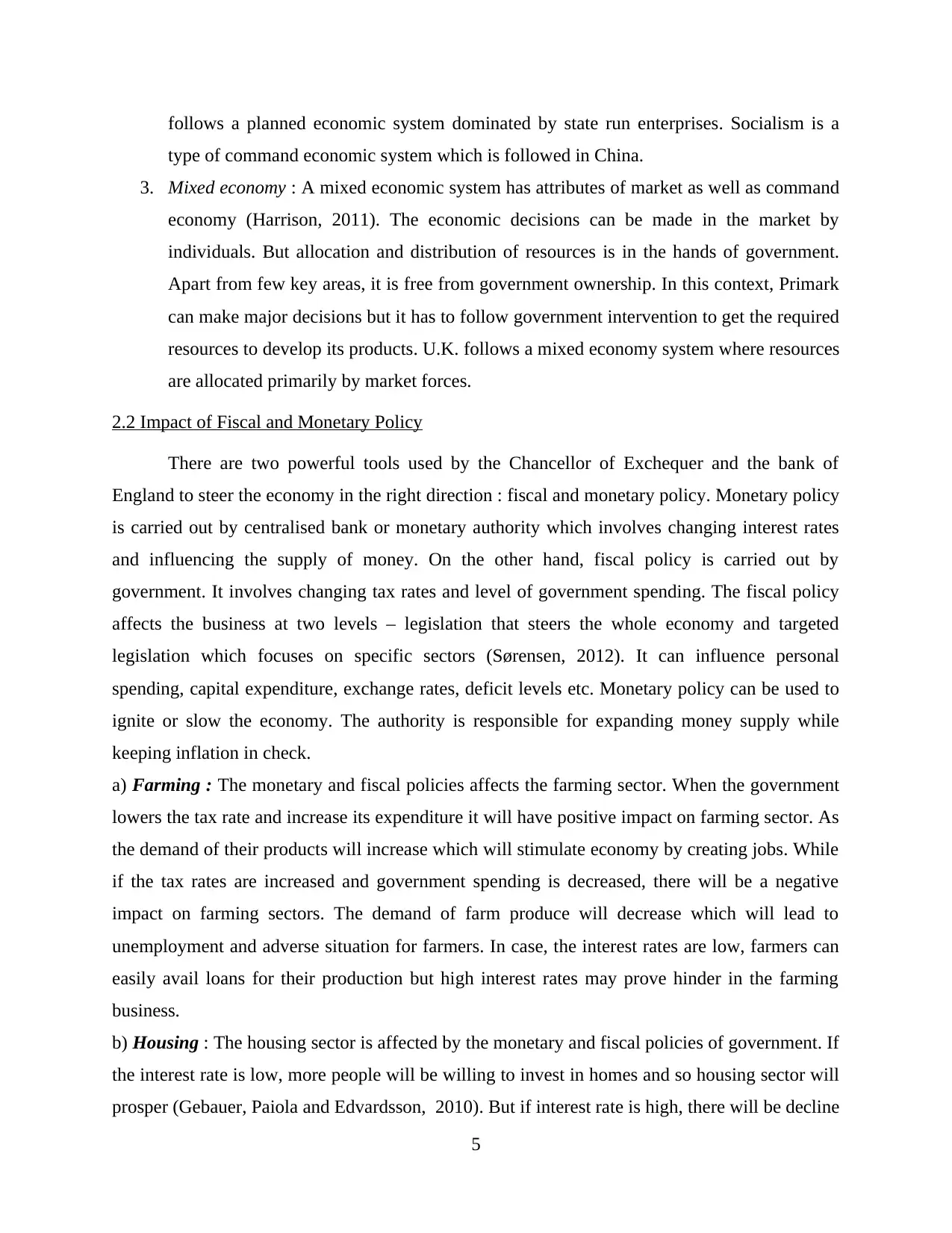
follows a planned economic system dominated by state run enterprises. Socialism is a
type of command economic system which is followed in China.
3. Mixed economy : A mixed economic system has attributes of market as well as command
economy (Harrison, 2011). The economic decisions can be made in the market by
individuals. But allocation and distribution of resources is in the hands of government.
Apart from few key areas, it is free from government ownership. In this context, Primark
can make major decisions but it has to follow government intervention to get the required
resources to develop its products. U.K. follows a mixed economy system where resources
are allocated primarily by market forces.
2.2 Impact of Fiscal and Monetary Policy
There are two powerful tools used by the Chancellor of Exchequer and the bank of
England to steer the economy in the right direction : fiscal and monetary policy. Monetary policy
is carried out by centralised bank or monetary authority which involves changing interest rates
and influencing the supply of money. On the other hand, fiscal policy is carried out by
government. It involves changing tax rates and level of government spending. The fiscal policy
affects the business at two levels – legislation that steers the whole economy and targeted
legislation which focuses on specific sectors (Sørensen, 2012). It can influence personal
spending, capital expenditure, exchange rates, deficit levels etc. Monetary policy can be used to
ignite or slow the economy. The authority is responsible for expanding money supply while
keeping inflation in check.
a) Farming : The monetary and fiscal policies affects the farming sector. When the government
lowers the tax rate and increase its expenditure it will have positive impact on farming sector. As
the demand of their products will increase which will stimulate economy by creating jobs. While
if the tax rates are increased and government spending is decreased, there will be a negative
impact on farming sectors. The demand of farm produce will decrease which will lead to
unemployment and adverse situation for farmers. In case, the interest rates are low, farmers can
easily avail loans for their production but high interest rates may prove hinder in the farming
business.
b) Housing : The housing sector is affected by the monetary and fiscal policies of government. If
the interest rate is low, more people will be willing to invest in homes and so housing sector will
prosper (Gebauer, Paiola and Edvardsson, 2010). But if interest rate is high, there will be decline
5
type of command economic system which is followed in China.
3. Mixed economy : A mixed economic system has attributes of market as well as command
economy (Harrison, 2011). The economic decisions can be made in the market by
individuals. But allocation and distribution of resources is in the hands of government.
Apart from few key areas, it is free from government ownership. In this context, Primark
can make major decisions but it has to follow government intervention to get the required
resources to develop its products. U.K. follows a mixed economy system where resources
are allocated primarily by market forces.
2.2 Impact of Fiscal and Monetary Policy
There are two powerful tools used by the Chancellor of Exchequer and the bank of
England to steer the economy in the right direction : fiscal and monetary policy. Monetary policy
is carried out by centralised bank or monetary authority which involves changing interest rates
and influencing the supply of money. On the other hand, fiscal policy is carried out by
government. It involves changing tax rates and level of government spending. The fiscal policy
affects the business at two levels – legislation that steers the whole economy and targeted
legislation which focuses on specific sectors (Sørensen, 2012). It can influence personal
spending, capital expenditure, exchange rates, deficit levels etc. Monetary policy can be used to
ignite or slow the economy. The authority is responsible for expanding money supply while
keeping inflation in check.
a) Farming : The monetary and fiscal policies affects the farming sector. When the government
lowers the tax rate and increase its expenditure it will have positive impact on farming sector. As
the demand of their products will increase which will stimulate economy by creating jobs. While
if the tax rates are increased and government spending is decreased, there will be a negative
impact on farming sectors. The demand of farm produce will decrease which will lead to
unemployment and adverse situation for farmers. In case, the interest rates are low, farmers can
easily avail loans for their production but high interest rates may prove hinder in the farming
business.
b) Housing : The housing sector is affected by the monetary and fiscal policies of government. If
the interest rate is low, more people will be willing to invest in homes and so housing sector will
prosper (Gebauer, Paiola and Edvardsson, 2010). But if interest rate is high, there will be decline
5
Paraphrase This Document
Need a fresh take? Get an instant paraphrase of this document with our AI Paraphraser
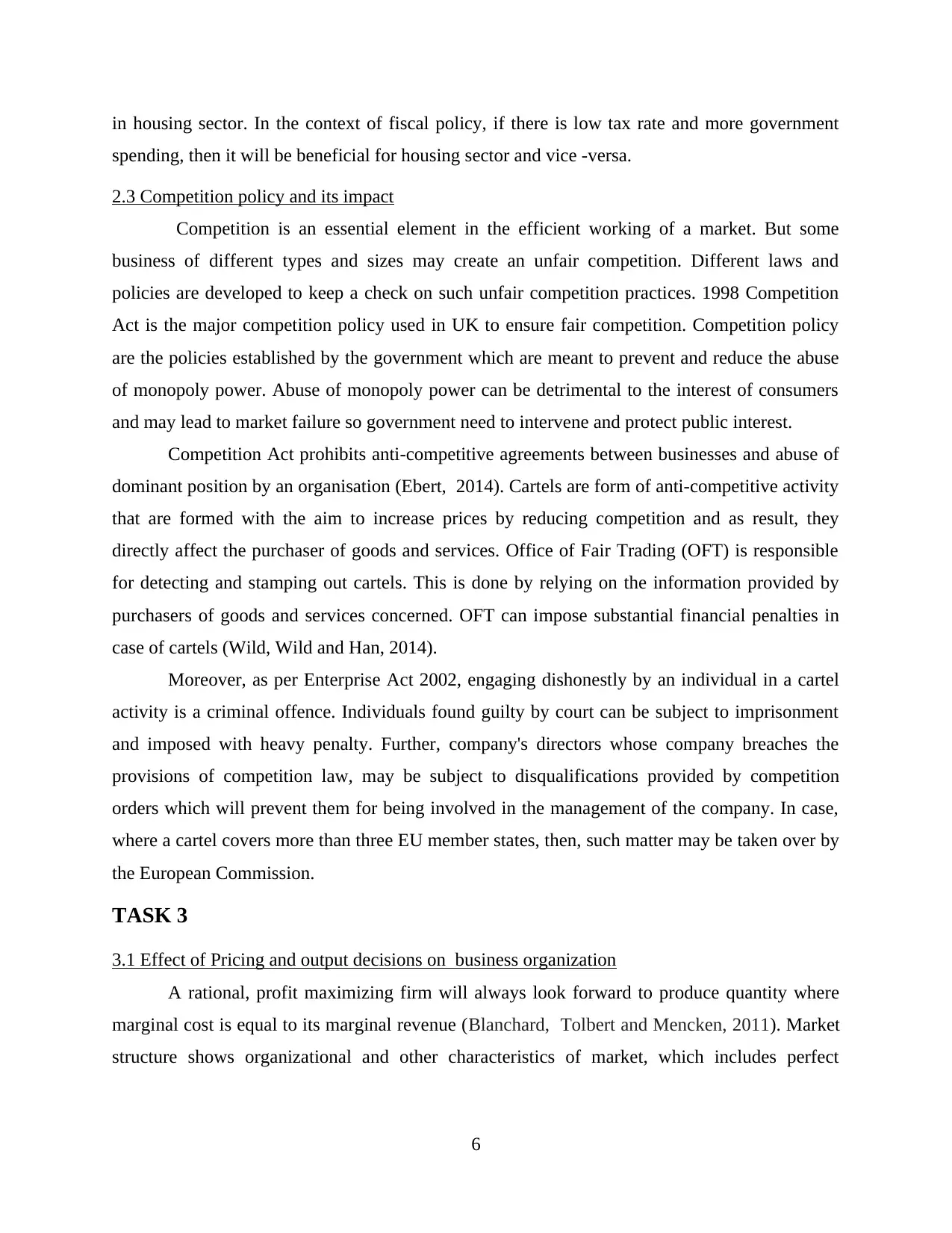
in housing sector. In the context of fiscal policy, if there is low tax rate and more government
spending, then it will be beneficial for housing sector and vice -versa.
2.3 Competition policy and its impact
Competition is an essential element in the efficient working of a market. But some
business of different types and sizes may create an unfair competition. Different laws and
policies are developed to keep a check on such unfair competition practices. 1998 Competition
Act is the major competition policy used in UK to ensure fair competition. Competition policy
are the policies established by the government which are meant to prevent and reduce the abuse
of monopoly power. Abuse of monopoly power can be detrimental to the interest of consumers
and may lead to market failure so government need to intervene and protect public interest.
Competition Act prohibits anti-competitive agreements between businesses and abuse of
dominant position by an organisation (Ebert, 2014). Cartels are form of anti-competitive activity
that are formed with the aim to increase prices by reducing competition and as result, they
directly affect the purchaser of goods and services. Office of Fair Trading (OFT) is responsible
for detecting and stamping out cartels. This is done by relying on the information provided by
purchasers of goods and services concerned. OFT can impose substantial financial penalties in
case of cartels (Wild, Wild and Han, 2014).
Moreover, as per Enterprise Act 2002, engaging dishonestly by an individual in a cartel
activity is a criminal offence. Individuals found guilty by court can be subject to imprisonment
and imposed with heavy penalty. Further, company's directors whose company breaches the
provisions of competition law, may be subject to disqualifications provided by competition
orders which will prevent them for being involved in the management of the company. In case,
where a cartel covers more than three EU member states, then, such matter may be taken over by
the European Commission.
TASK 3
3.1 Effect of Pricing and output decisions on business organization
A rational, profit maximizing firm will always look forward to produce quantity where
marginal cost is equal to its marginal revenue (Blanchard, Tolbert and Mencken, 2011). Market
structure shows organizational and other characteristics of market, which includes perfect
6
spending, then it will be beneficial for housing sector and vice -versa.
2.3 Competition policy and its impact
Competition is an essential element in the efficient working of a market. But some
business of different types and sizes may create an unfair competition. Different laws and
policies are developed to keep a check on such unfair competition practices. 1998 Competition
Act is the major competition policy used in UK to ensure fair competition. Competition policy
are the policies established by the government which are meant to prevent and reduce the abuse
of monopoly power. Abuse of monopoly power can be detrimental to the interest of consumers
and may lead to market failure so government need to intervene and protect public interest.
Competition Act prohibits anti-competitive agreements between businesses and abuse of
dominant position by an organisation (Ebert, 2014). Cartels are form of anti-competitive activity
that are formed with the aim to increase prices by reducing competition and as result, they
directly affect the purchaser of goods and services. Office of Fair Trading (OFT) is responsible
for detecting and stamping out cartels. This is done by relying on the information provided by
purchasers of goods and services concerned. OFT can impose substantial financial penalties in
case of cartels (Wild, Wild and Han, 2014).
Moreover, as per Enterprise Act 2002, engaging dishonestly by an individual in a cartel
activity is a criminal offence. Individuals found guilty by court can be subject to imprisonment
and imposed with heavy penalty. Further, company's directors whose company breaches the
provisions of competition law, may be subject to disqualifications provided by competition
orders which will prevent them for being involved in the management of the company. In case,
where a cartel covers more than three EU member states, then, such matter may be taken over by
the European Commission.
TASK 3
3.1 Effect of Pricing and output decisions on business organization
A rational, profit maximizing firm will always look forward to produce quantity where
marginal cost is equal to its marginal revenue (Blanchard, Tolbert and Mencken, 2011). Market
structure shows organizational and other characteristics of market, which includes perfect
6
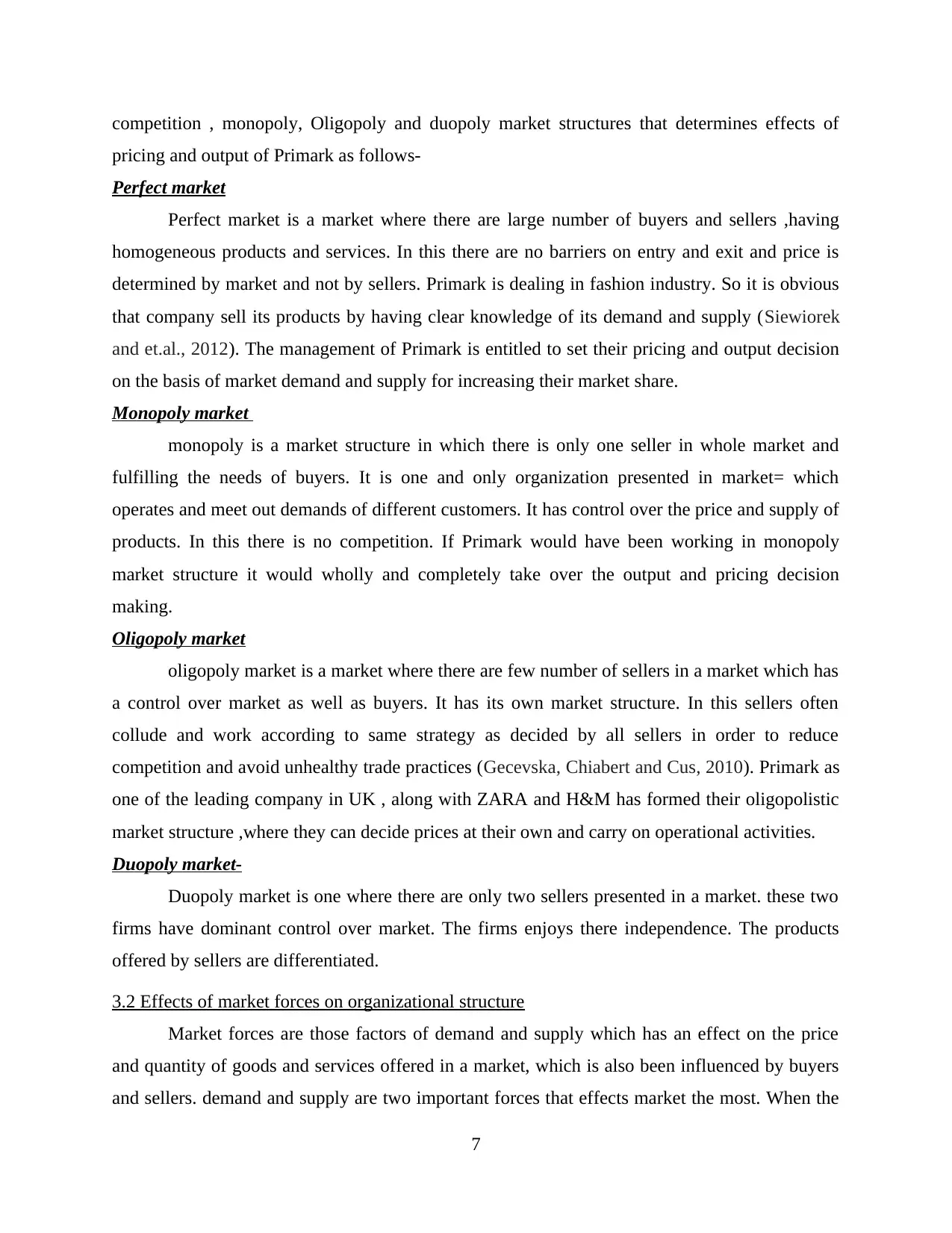
competition , monopoly, Oligopoly and duopoly market structures that determines effects of
pricing and output of Primark as follows-
Perfect market
Perfect market is a market where there are large number of buyers and sellers ,having
homogeneous products and services. In this there are no barriers on entry and exit and price is
determined by market and not by sellers. Primark is dealing in fashion industry. So it is obvious
that company sell its products by having clear knowledge of its demand and supply (Siewiorek
and et.al., 2012). The management of Primark is entitled to set their pricing and output decision
on the basis of market demand and supply for increasing their market share.
Monopoly market
monopoly is a market structure in which there is only one seller in whole market and
fulfilling the needs of buyers. It is one and only organization presented in market= which
operates and meet out demands of different customers. It has control over the price and supply of
products. In this there is no competition. If Primark would have been working in monopoly
market structure it would wholly and completely take over the output and pricing decision
making.
Oligopoly market
oligopoly market is a market where there are few number of sellers in a market which has
a control over market as well as buyers. It has its own market structure. In this sellers often
collude and work according to same strategy as decided by all sellers in order to reduce
competition and avoid unhealthy trade practices (Gecevska, Chiabert and Cus, 2010). Primark as
one of the leading company in UK , along with ZARA and H&M has formed their oligopolistic
market structure ,where they can decide prices at their own and carry on operational activities.
Duopoly market-
Duopoly market is one where there are only two sellers presented in a market. these two
firms have dominant control over market. The firms enjoys there independence. The products
offered by sellers are differentiated.
3.2 Effects of market forces on organizational structure
Market forces are those factors of demand and supply which has an effect on the price
and quantity of goods and services offered in a market, which is also been influenced by buyers
and sellers. demand and supply are two important forces that effects market the most. When the
7
pricing and output of Primark as follows-
Perfect market
Perfect market is a market where there are large number of buyers and sellers ,having
homogeneous products and services. In this there are no barriers on entry and exit and price is
determined by market and not by sellers. Primark is dealing in fashion industry. So it is obvious
that company sell its products by having clear knowledge of its demand and supply (Siewiorek
and et.al., 2012). The management of Primark is entitled to set their pricing and output decision
on the basis of market demand and supply for increasing their market share.
Monopoly market
monopoly is a market structure in which there is only one seller in whole market and
fulfilling the needs of buyers. It is one and only organization presented in market= which
operates and meet out demands of different customers. It has control over the price and supply of
products. In this there is no competition. If Primark would have been working in monopoly
market structure it would wholly and completely take over the output and pricing decision
making.
Oligopoly market
oligopoly market is a market where there are few number of sellers in a market which has
a control over market as well as buyers. It has its own market structure. In this sellers often
collude and work according to same strategy as decided by all sellers in order to reduce
competition and avoid unhealthy trade practices (Gecevska, Chiabert and Cus, 2010). Primark as
one of the leading company in UK , along with ZARA and H&M has formed their oligopolistic
market structure ,where they can decide prices at their own and carry on operational activities.
Duopoly market-
Duopoly market is one where there are only two sellers presented in a market. these two
firms have dominant control over market. The firms enjoys there independence. The products
offered by sellers are differentiated.
3.2 Effects of market forces on organizational structure
Market forces are those factors of demand and supply which has an effect on the price
and quantity of goods and services offered in a market, which is also been influenced by buyers
and sellers. demand and supply are two important forces that effects market the most. When the
7
⊘ This is a preview!⊘
Do you want full access?
Subscribe today to unlock all pages.

Trusted by 1+ million students worldwide
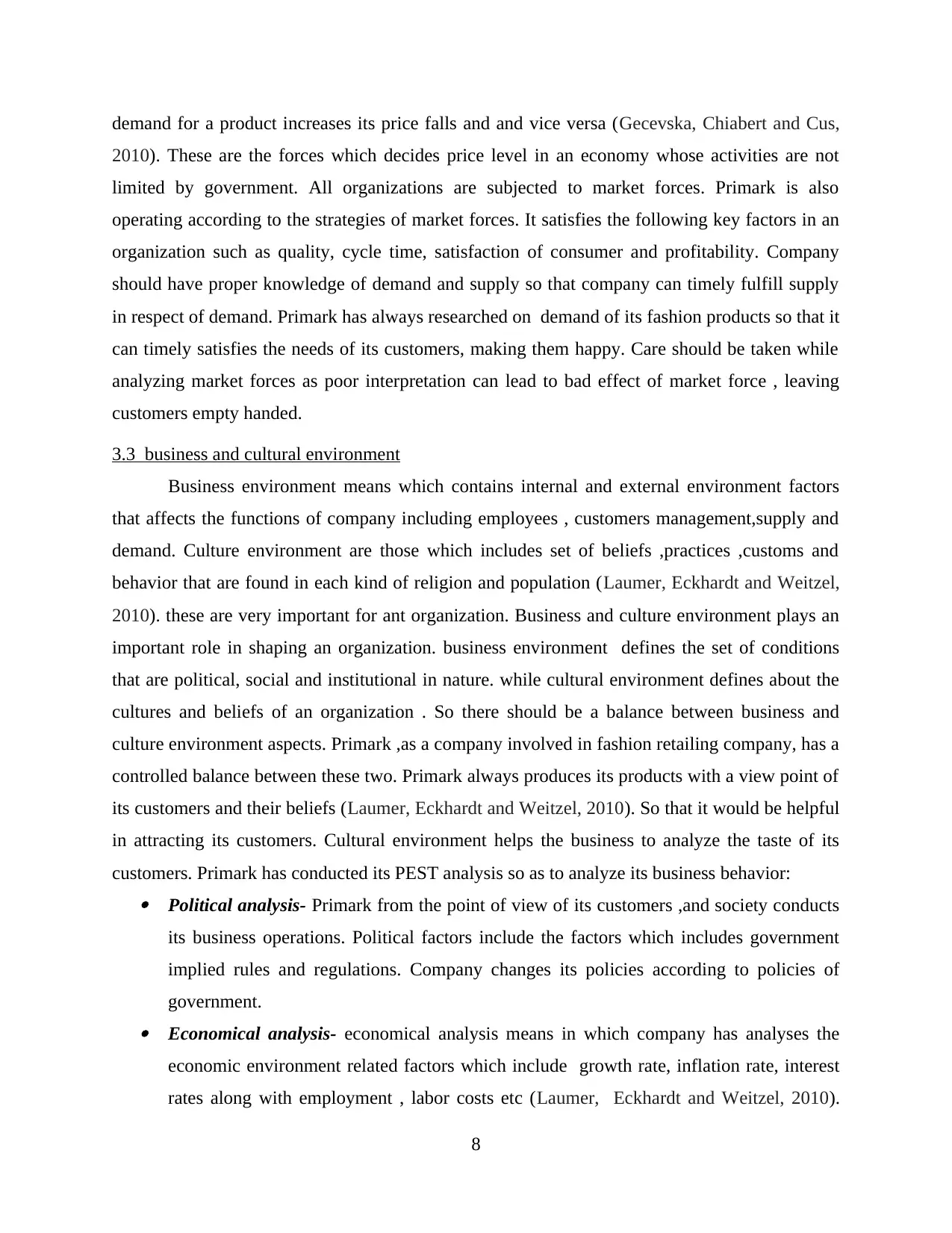
demand for a product increases its price falls and and vice versa (Gecevska, Chiabert and Cus,
2010). These are the forces which decides price level in an economy whose activities are not
limited by government. All organizations are subjected to market forces. Primark is also
operating according to the strategies of market forces. It satisfies the following key factors in an
organization such as quality, cycle time, satisfaction of consumer and profitability. Company
should have proper knowledge of demand and supply so that company can timely fulfill supply
in respect of demand. Primark has always researched on demand of its fashion products so that it
can timely satisfies the needs of its customers, making them happy. Care should be taken while
analyzing market forces as poor interpretation can lead to bad effect of market force , leaving
customers empty handed.
3.3 business and cultural environment
Business environment means which contains internal and external environment factors
that affects the functions of company including employees , customers management,supply and
demand. Culture environment are those which includes set of beliefs ,practices ,customs and
behavior that are found in each kind of religion and population (Laumer, Eckhardt and Weitzel,
2010). these are very important for ant organization. Business and culture environment plays an
important role in shaping an organization. business environment defines the set of conditions
that are political, social and institutional in nature. while cultural environment defines about the
cultures and beliefs of an organization . So there should be a balance between business and
culture environment aspects. Primark ,as a company involved in fashion retailing company, has a
controlled balance between these two. Primark always produces its products with a view point of
its customers and their beliefs (Laumer, Eckhardt and Weitzel, 2010). So that it would be helpful
in attracting its customers. Cultural environment helps the business to analyze the taste of its
customers. Primark has conducted its PEST analysis so as to analyze its business behavior: Political analysis- Primark from the point of view of its customers ,and society conducts
its business operations. Political factors include the factors which includes government
implied rules and regulations. Company changes its policies according to policies of
government. Economical analysis- economical analysis means in which company has analyses the
economic environment related factors which include growth rate, inflation rate, interest
rates along with employment , labor costs etc (Laumer, Eckhardt and Weitzel, 2010).
8
2010). These are the forces which decides price level in an economy whose activities are not
limited by government. All organizations are subjected to market forces. Primark is also
operating according to the strategies of market forces. It satisfies the following key factors in an
organization such as quality, cycle time, satisfaction of consumer and profitability. Company
should have proper knowledge of demand and supply so that company can timely fulfill supply
in respect of demand. Primark has always researched on demand of its fashion products so that it
can timely satisfies the needs of its customers, making them happy. Care should be taken while
analyzing market forces as poor interpretation can lead to bad effect of market force , leaving
customers empty handed.
3.3 business and cultural environment
Business environment means which contains internal and external environment factors
that affects the functions of company including employees , customers management,supply and
demand. Culture environment are those which includes set of beliefs ,practices ,customs and
behavior that are found in each kind of religion and population (Laumer, Eckhardt and Weitzel,
2010). these are very important for ant organization. Business and culture environment plays an
important role in shaping an organization. business environment defines the set of conditions
that are political, social and institutional in nature. while cultural environment defines about the
cultures and beliefs of an organization . So there should be a balance between business and
culture environment aspects. Primark ,as a company involved in fashion retailing company, has a
controlled balance between these two. Primark always produces its products with a view point of
its customers and their beliefs (Laumer, Eckhardt and Weitzel, 2010). So that it would be helpful
in attracting its customers. Cultural environment helps the business to analyze the taste of its
customers. Primark has conducted its PEST analysis so as to analyze its business behavior: Political analysis- Primark from the point of view of its customers ,and society conducts
its business operations. Political factors include the factors which includes government
implied rules and regulations. Company changes its policies according to policies of
government. Economical analysis- economical analysis means in which company has analyses the
economic environment related factors which include growth rate, inflation rate, interest
rates along with employment , labor costs etc (Laumer, Eckhardt and Weitzel, 2010).
8
Paraphrase This Document
Need a fresh take? Get an instant paraphrase of this document with our AI Paraphraser
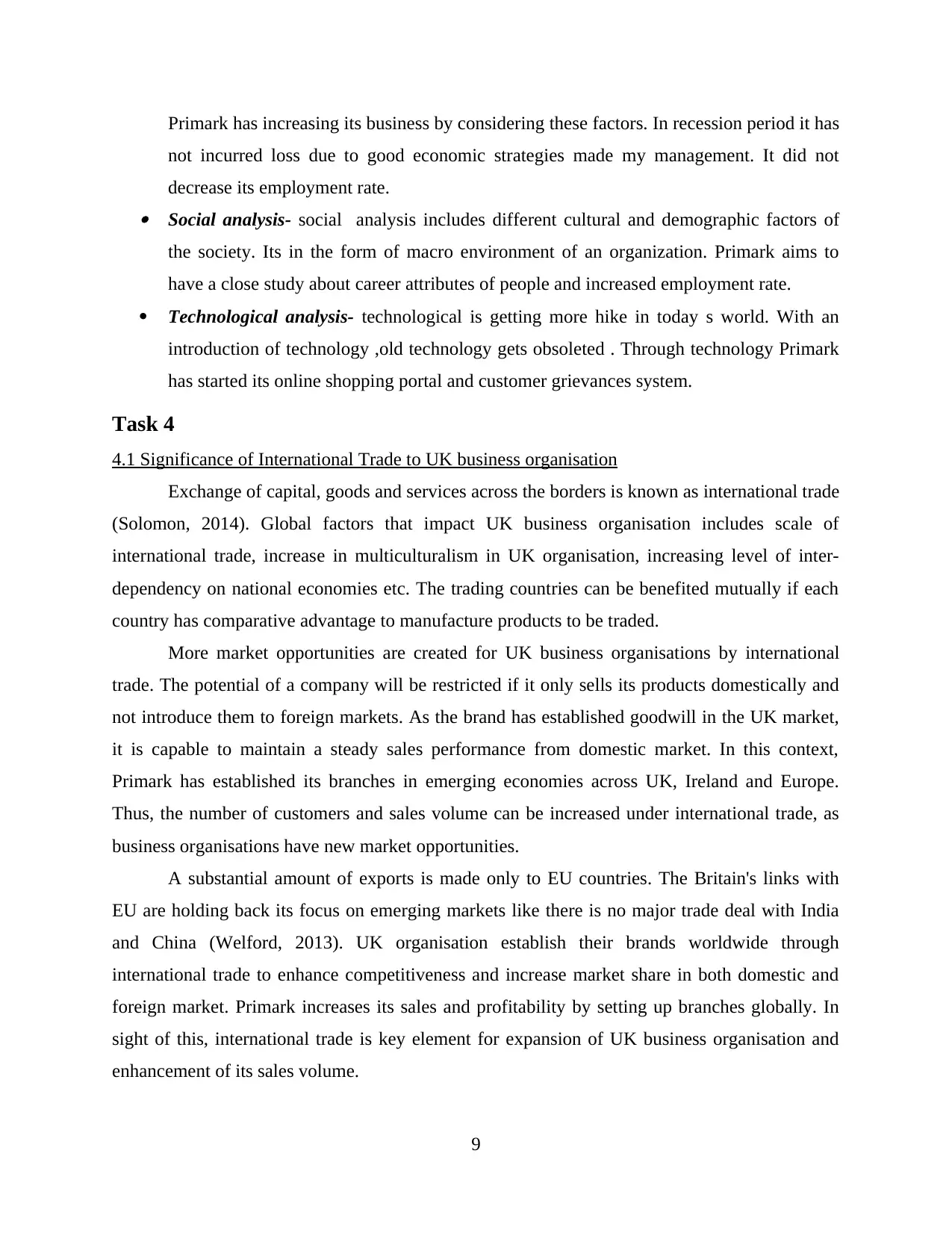
Primark has increasing its business by considering these factors. In recession period it has
not incurred loss due to good economic strategies made my management. It did not
decrease its employment rate. Social analysis- social analysis includes different cultural and demographic factors of
the society. Its in the form of macro environment of an organization. Primark aims to
have a close study about career attributes of people and increased employment rate.
Technological analysis- technological is getting more hike in today s world. With an
introduction of technology ,old technology gets obsoleted . Through technology Primark
has started its online shopping portal and customer grievances system.
Task 4
4.1 Significance of International Trade to UK business organisation
Exchange of capital, goods and services across the borders is known as international trade
(Solomon, 2014). Global factors that impact UK business organisation includes scale of
international trade, increase in multiculturalism in UK organisation, increasing level of inter-
dependency on national economies etc. The trading countries can be benefited mutually if each
country has comparative advantage to manufacture products to be traded.
More market opportunities are created for UK business organisations by international
trade. The potential of a company will be restricted if it only sells its products domestically and
not introduce them to foreign markets. As the brand has established goodwill in the UK market,
it is capable to maintain a steady sales performance from domestic market. In this context,
Primark has established its branches in emerging economies across UK, Ireland and Europe.
Thus, the number of customers and sales volume can be increased under international trade, as
business organisations have new market opportunities.
A substantial amount of exports is made only to EU countries. The Britain's links with
EU are holding back its focus on emerging markets like there is no major trade deal with India
and China (Welford, 2013). UK organisation establish their brands worldwide through
international trade to enhance competitiveness and increase market share in both domestic and
foreign market. Primark increases its sales and profitability by setting up branches globally. In
sight of this, international trade is key element for expansion of UK business organisation and
enhancement of its sales volume.
9
not incurred loss due to good economic strategies made my management. It did not
decrease its employment rate. Social analysis- social analysis includes different cultural and demographic factors of
the society. Its in the form of macro environment of an organization. Primark aims to
have a close study about career attributes of people and increased employment rate.
Technological analysis- technological is getting more hike in today s world. With an
introduction of technology ,old technology gets obsoleted . Through technology Primark
has started its online shopping portal and customer grievances system.
Task 4
4.1 Significance of International Trade to UK business organisation
Exchange of capital, goods and services across the borders is known as international trade
(Solomon, 2014). Global factors that impact UK business organisation includes scale of
international trade, increase in multiculturalism in UK organisation, increasing level of inter-
dependency on national economies etc. The trading countries can be benefited mutually if each
country has comparative advantage to manufacture products to be traded.
More market opportunities are created for UK business organisations by international
trade. The potential of a company will be restricted if it only sells its products domestically and
not introduce them to foreign markets. As the brand has established goodwill in the UK market,
it is capable to maintain a steady sales performance from domestic market. In this context,
Primark has established its branches in emerging economies across UK, Ireland and Europe.
Thus, the number of customers and sales volume can be increased under international trade, as
business organisations have new market opportunities.
A substantial amount of exports is made only to EU countries. The Britain's links with
EU are holding back its focus on emerging markets like there is no major trade deal with India
and China (Welford, 2013). UK organisation establish their brands worldwide through
international trade to enhance competitiveness and increase market share in both domestic and
foreign market. Primark increases its sales and profitability by setting up branches globally. In
sight of this, international trade is key element for expansion of UK business organisation and
enhancement of its sales volume.
9
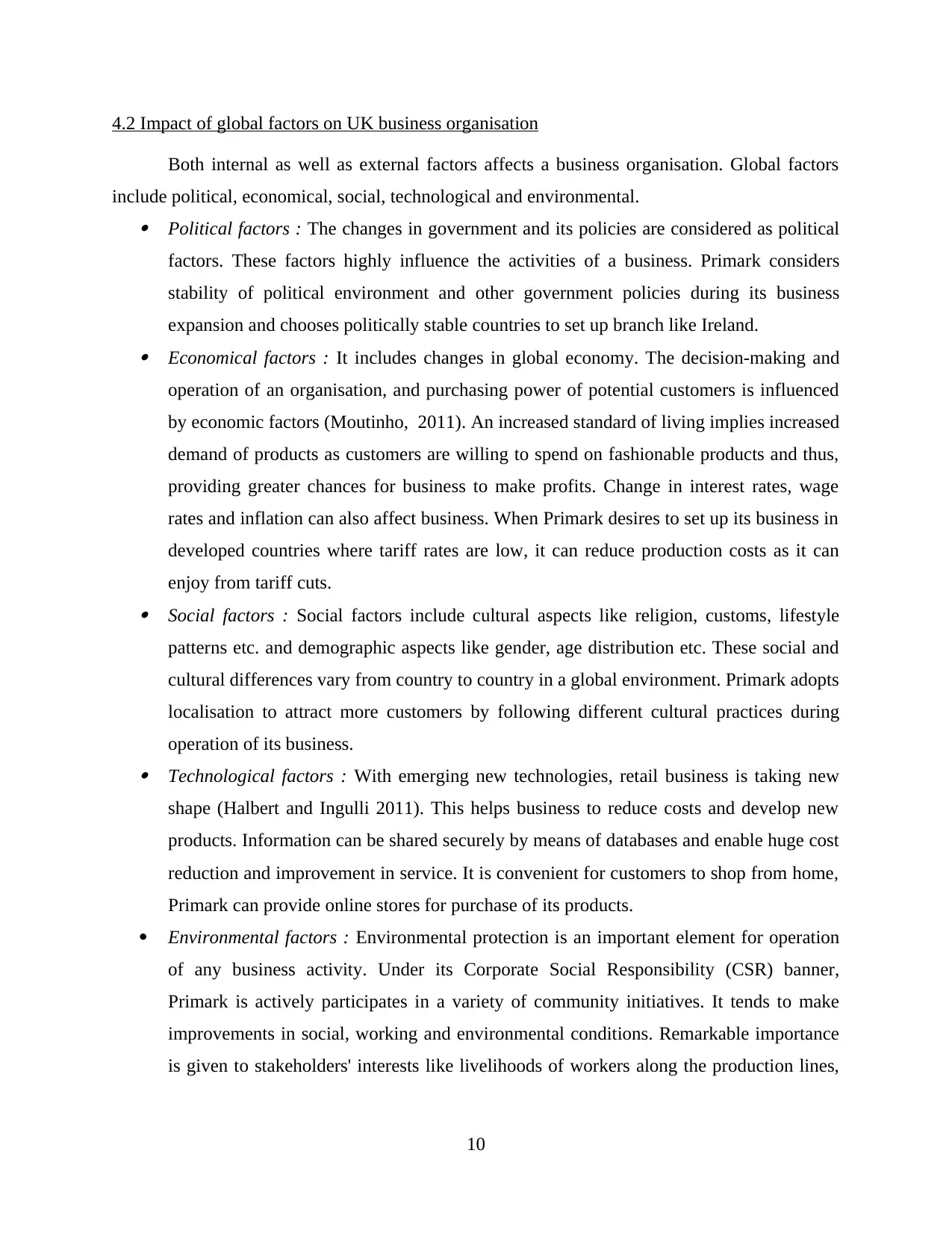
4.2 Impact of global factors on UK business organisation
Both internal as well as external factors affects a business organisation. Global factors
include political, economical, social, technological and environmental. Political factors : The changes in government and its policies are considered as political
factors. These factors highly influence the activities of a business. Primark considers
stability of political environment and other government policies during its business
expansion and chooses politically stable countries to set up branch like Ireland. Economical factors : It includes changes in global economy. The decision-making and
operation of an organisation, and purchasing power of potential customers is influenced
by economic factors (Moutinho, 2011). An increased standard of living implies increased
demand of products as customers are willing to spend on fashionable products and thus,
providing greater chances for business to make profits. Change in interest rates, wage
rates and inflation can also affect business. When Primark desires to set up its business in
developed countries where tariff rates are low, it can reduce production costs as it can
enjoy from tariff cuts. Social factors : Social factors include cultural aspects like religion, customs, lifestyle
patterns etc. and demographic aspects like gender, age distribution etc. These social and
cultural differences vary from country to country in a global environment. Primark adopts
localisation to attract more customers by following different cultural practices during
operation of its business. Technological factors : With emerging new technologies, retail business is taking new
shape (Halbert and Ingulli 2011). This helps business to reduce costs and develop new
products. Information can be shared securely by means of databases and enable huge cost
reduction and improvement in service. It is convenient for customers to shop from home,
Primark can provide online stores for purchase of its products.
Environmental factors : Environmental protection is an important element for operation
of any business activity. Under its Corporate Social Responsibility (CSR) banner,
Primark is actively participates in a variety of community initiatives. It tends to make
improvements in social, working and environmental conditions. Remarkable importance
is given to stakeholders' interests like livelihoods of workers along the production lines,
10
Both internal as well as external factors affects a business organisation. Global factors
include political, economical, social, technological and environmental. Political factors : The changes in government and its policies are considered as political
factors. These factors highly influence the activities of a business. Primark considers
stability of political environment and other government policies during its business
expansion and chooses politically stable countries to set up branch like Ireland. Economical factors : It includes changes in global economy. The decision-making and
operation of an organisation, and purchasing power of potential customers is influenced
by economic factors (Moutinho, 2011). An increased standard of living implies increased
demand of products as customers are willing to spend on fashionable products and thus,
providing greater chances for business to make profits. Change in interest rates, wage
rates and inflation can also affect business. When Primark desires to set up its business in
developed countries where tariff rates are low, it can reduce production costs as it can
enjoy from tariff cuts. Social factors : Social factors include cultural aspects like religion, customs, lifestyle
patterns etc. and demographic aspects like gender, age distribution etc. These social and
cultural differences vary from country to country in a global environment. Primark adopts
localisation to attract more customers by following different cultural practices during
operation of its business. Technological factors : With emerging new technologies, retail business is taking new
shape (Halbert and Ingulli 2011). This helps business to reduce costs and develop new
products. Information can be shared securely by means of databases and enable huge cost
reduction and improvement in service. It is convenient for customers to shop from home,
Primark can provide online stores for purchase of its products.
Environmental factors : Environmental protection is an important element for operation
of any business activity. Under its Corporate Social Responsibility (CSR) banner,
Primark is actively participates in a variety of community initiatives. It tends to make
improvements in social, working and environmental conditions. Remarkable importance
is given to stakeholders' interests like livelihoods of workers along the production lines,
10
⊘ This is a preview!⊘
Do you want full access?
Subscribe today to unlock all pages.

Trusted by 1+ million students worldwide
1 out of 14
Related Documents
Your All-in-One AI-Powered Toolkit for Academic Success.
+13062052269
info@desklib.com
Available 24*7 on WhatsApp / Email
![[object Object]](/_next/static/media/star-bottom.7253800d.svg)
Unlock your academic potential
Copyright © 2020–2025 A2Z Services. All Rights Reserved. Developed and managed by ZUCOL.





